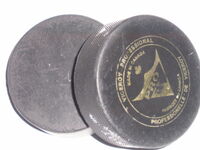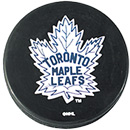
Two standard hockey pucks.
A puck is a disk used in various types of games serving the same functions as a ball in ball games. The best-known use of pucks is in ice hockey, a major international sport.
Ice hockey requires a hard disk of vulcanized rubber. A standard ice hockey puck is black, 1 inch thick (25.4 mm), 3 inches in diameter (76.2 mm), and weighs between 5.5 and 6 ounces (156-170 g); some pucks are heavier or lighter than standard (see below). Pucks are often marked with silkscreened team or league logos on one or both faces.[1]
The game evolved in Great Britain by 1820[1] from bandy, which was played with a ball on ice by field hockey players who wanted to continue to train during the European winters. Early forms of ice hockey, once known as "Canadian rules bandy", used a ball rather than a puck when it first came to North America from Europe. Early players of the game found that the rubber ball used in field hockey was far too active on the hard ice surface. Today, pucks are frozen a few hours before the game to further reduce bouncing during play.
The origin of the word "puck" is obscure. Though commonly believed to be[1] it is evidently not connected to Shakespeare's Puck or the mythical Puck. The Oxford English Dictionary suggests the name is related to the verb "to puck" (a cognate of "poke") used in the game of hurling for striking or pushing the ball, from the Scottish Gaelic puc or the Irish poc, meaning to poke, punch or deliver a blow:
PUCK, a blow. He gave him a puck of a stick on the head. More commonly applied to a punch or blow of the horns of a cow or goat! (Ask Little Britainers!) The cow gave him a puck (or pucked him) with her horns and knocked him down.
The blow given by a hurler to the ball with his caman or hurley (stick) is always called a puck.
Also, a free shot in hurling is a free puck.

Hockey puck bearing an early-style logo of the Toronto Maple Leafs of the National Hockey League.
It is possible that Halifax natives, many of whom were Irish and played hurley, may have introduced the word to Canada. The first known printed reference was in Montreal, in 1876, just a year after the first indoor game was played there.
Variations
A number of variations on the standard black, 6 oz (170 g) hockey puck exist. One of the most common is a blue, 4 oz (113 g) puck that is used for training younger players who are not yet able to use a standard puck. Heavier 10 oz (283 g) training pucks, typically reddish pink or reddish orange in color, are also available for players looking to develop the strength of their shots or improve their stick handling skills. Players looking to increase wrist strength often practice with steel pucks which weigh 2 lb (900 g); these pucks are not used for shooting, as they could seriously harm other players. A hollow, light-weight fluorescent orange puck is available for road or floor hockey. Other variants, some with plastic ball bearings or glides, are available for use for road or roller hockey.
The FoxTrax "smart puck" was developed by the FOX television network when it held NHL broadcasting rights for the U.S. The puck had integrated electronics to track its position on screen; a blue streak traced the path of the puck across the ice. The streak would turn red if the puck was shot especially hard. This was an experiment in broadcasting intended to help viewers unfamiliar with hockey to better follow the game by making the puck more visible. It was ill-received by traditional hockey fans and did not meet its intended objective of drawing new viewers to the game. The experiment was short-lived (1996–98).
In game play
During a game, pucks can reach speeds of 100 miles per hour (160–km/h) or more when struck, and are potentially dangerous to players and spectators. Puck-related injuries at hockey games are not uncommon. This led to the evolution of various types of protective gear for players, most notably the goalie mask.
The most serious incident involving a spectator took place on March 18, 2002, when a thirteen year old girl, Brittanie Cecil, died two days after being struck on the head by a hockey puck deflected into the crowd at a National Hockey League game between the Calgary Flames and Columbus Blue Jackets in Columbus. This is the only known incident of this type to have occurred in the history of the league. Partly as a result of this tragedy, plexiglass panels sitting atop the boards of hockey rinks to protect spectators have been supplemented with mesh nets that extend above the upper edge of the plexiglass.
"Icing the puck" is shooting the puck from the defending player's half of the playing surface (their side of the center red line) across the opposing teams goal line on either side of the goal, as a delaying tactic or a (sometimes desperate) defensive play intended to shift the momentum of play away from the offensive team. Except when the defending team is short-handed because of a penalty, it is a rule infraction that generally results in a stoppage of play to return the puck to the offending team's end of the ice for a faceoff. Since the resumption of play in the National Hockey League after the 2004–05 lockout, a team that has a player ice the puck also must keep the same players on the ice, for the ensuing face-off, as were on the ice when the icing infraction happened.
During the 2005–06 season, a rule was implemented which penalizes any player intentionally or accidentally shooting the puck out of the rink from their team's defensive zone. The rule was intended to eliminate the contradictory nature of the previous version of the rule, which only applied to goaltenders.
Manufacture
NHL regulation pucks were not required for professional play until the 1990–91 season, but were standardized for consistent play and ease of manufacture half a century earlier, by Art Ross, in 1940.[1] Major manufacturers of pucks exist only in Canada, India, Russia, Slovakia, the Czech Republic and the People's Republic of China.[1]
The black rubber of the puck is made up of a mix of natural rubber, antioxidants, bonding materials and other chemicals to achieve a balance of hardness and resilience. This mixture is then turned in a machine composed of metal rollers, where workers add extra natural rubber, and ensure that the mixing is even. Samples are then put into a machine that analyzes if the rubber will harden at the right temperature. An automated appartus, called a pultrusion machine,[1] extrudes the rubber into long circular logs that are three inches in diameter and then cut into one inch thick pieces while it is still soft. These pre-forms are then manually put into molds that are the exact size of a finished puck.[2] There are up to 200 mold cavities per molding palett, capable of producing up to 5,000 pucks per week.[1] The molds are then compressed. This compression may be done cold[1] and or with the molds heated to 300 degrees Fahrenheit for 18 minutes,[2], depending upon the proprietary methods of the manufacturer. They come out hard and then are allowed to site for 24 hours. Each puck is manually cleaned with a trimmer machine to get rid of excess rubber. The molding process adds a diamond cross-hatch texture around the edge of the puck for more friction between the stick and puck for better control and puck handling.[2]
Souvenir and practice pucks are made by a similar but faster process, that uses larger pre-forms, 4–5 in (10–13 cm) thick, puts them into molds automatically, and applies more pressure and heat over a shorter period of time to compress the puck into the standard size. This allows approximately twice as many pucks to be manufactured in the same time period as the more exacting production of NHL regulation pucks.[1]
